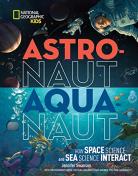BKMT READING GUIDES
Astronaut-Aquanaut: How Space Science and Sea Science Interact (National Geographic Kids)
by Jennifer Swanson
Published: 2018-01-09
Hardcover : 96 pages
Hardcover : 96 pages
0 members reading this now
1 club reading this now
0 members have read this book
1 club reading this now
0 members have read this book
Think space and the ocean don’t go together? Think again. Take an amazing journey UP in space and deep DOWN in the ocean to experience far-off places of our planet. Packed with vivid images, comments from real-life astronauts and aquanauts, and activities, this book inspires imagination ...
No other editions available.
Jump to
Introduction
Think space and the ocean don’t go together? Think again. Take an amazing journey UP in space and deep DOWN in the ocean to experience far-off places of our planet. Packed with vivid images, comments from real-life astronauts and aquanauts, and activities, this book inspires imagination in all future explorers. Junior Library Guild Selection. NSTA Best STEM book, California Reading Association Gold Award, Florida Book Award.
Extra activities found on my website include: a downloadable quiz, teachers guide, and fun book trailer video.
Excerpt
Introduction: Up and Down Deep space and the deep sea. You might not think they go together. They are two very different places. One is high above the Earth. The other stretches miles deep down below. One is a huge empty vacuum and the other is filled with water. Yet deep space and the deep sea are actually similar in many ways, too. The deep sea is a dark, mysterious environment with colossal mountains and bottomless pits. Places in outer space have those, too. The deep sea is home to volcanoes, earthquakes, and swirling vortexes. So is deep space. Do you know what both of these places don’t have? Noise. They are both eerily silent. When you are actually diving deep underwater or in walking in space there is no noise at all, except maybe the sound of you breathing inside your suit. Did you know that going up in space is very similar to going underwater? Traveling in these two places is incredibly similar, too. Astronauts and aquanauts both have to worry about pressure, temperature, climate, and most importantly, how to survive in a remote and somewhat hostile environment. With as dangerous as space and the deep sea sound, why would anyone go there? Exploration. Humans are curious beings. We want to know more about the places where we live, work, and exist around us, w. Whether that means riding a rocket into space or submerging miles under down into the ocean, we are excited to do it. Humans have already travelled to both places and brought back amazing information for scientists to study. But there is so much more to learn. There is a great need for new explorers. Scientists, engineers, mission control specialists, astronauts and even journalists and teachers can all be part of an exploration team. You, too, can become an explorer. Will you go up in space? Or down under the sea? Whether you choose space or sea, your mission is to learn all you can about each of these places. You need to understand the climate, conditions, and most importantly how to survive. You will train, learn what to pack, how to eat, sleep, and gather information, and use technology to send that data back to scientists here back on Earth’s surface. Can’t decide if you’d like to go to space or underwater? You can do both. Some of the planets in our solar system have seas so deep that satellites can’t see the bottom. Imagine that. You could be a deep sea diver and go into space! So if you want to climb a mountain on a new planet or slide down a rocky abyss into the deepest parts of the ocean, this is the place for you. Join us on an amazing journey as we go Up in Space and dive deep Down in the Ocean to explore the far-off places of our planet and the solar system. [ Sidebar: What is the most exciting part about diving/ being an aquanaut? - Elizabeth Magee, Aquanaut “The most exciting part of scuba diving is being able to witness nature in its true form. Normally we only get to witness sea creatures by bringing them out of the water. When you scuba dive you get to join the animals in their comfort zone so you get to see them hunting, hiding, eating, and living just as they would if you weren’t there.” ] ? Chapter One: Exploring New Environments The environments in deep space and the deep ocean are quite hostile to humans. Exploring deep space and deep ocean isn’t exactly a walk in the park. Neither place is warm and cozy. In fact, in both places, humans need to bring their own oxygen tanks just to survive. They had also better wear a warm, protective suit. Space is cold! The vast depths of the ocean aren’t any warmer. A few minutes unexposed in either place and a person could freeze to death. Air pressure is also something every human explorer needs to understand. As you go deeper under the water, the pressure increases. But in space, there is no air so there isn’t any air pressure. That’s good, right? Not exactly. Humans are used to having air push down on them on Earth. Without air pressure, our blood vessels would expand and most likely burst. That would not be a good thing. Darkness Descends Do you like the dark? Let’s hope so. It is very dark underwater and in outer space, unless astronauts are looking directly at the sun or see light reflected off an object. Of course, in all of the pictures you see, space appears to be completely dark.. In order for our eyes to see light, it must bounce off of something, or be and scattered. On Earth, the sun’s rays bounce off the atmosphere. In space there is no atmosphere. That means that the light cannot be scattered. Instead, it is simply swallowed up by the vast emptiness. Think of it this way:. Space is like a completely dark room. If you are in a dark room, the first thing you do is turn on your desk light. Now you can see. The reason why you can see is that the light from the lamp is bouncing back from the wall. But in space, there are no walls. If you turn on a lamp in space, You will be able to see the light from the bulb, but that is it. The rest of the “room” will be covered in darkness. In space the light reflects off of the objects that are there: planets, asteroids, and other stars. If astronauts are looking directly at the sun, or at the Earth, which their spaceships typically face, they may see a lot of light. That is because the Earth reflects the light from the sun. But when the spaceship is on the opposite side of the Earth from the sun, the light is not reflected back. There’s nothing to reflect the light. Instead, , it is absorbed into the empty space. And when all light is absorbed, the only color left to see is the color we call “black.” That is why space appears black in all the photographs, all the light has been absorbed. Just like space, deep under the ocean is also somewhat very dark. It makes sense. The light source for the ocean is also the sun. The sun, at its closest, is more than 91 million miles (146 million km) away from Earth. Despite the distance, the sun’s rays penetrate the water, but only to approximately 656 feet (200 meters). While that might seem like a long way, it’s not. That’s less than one percent of the ocean’s depth. Tiny amounts of sunlight can sometimes reach as far as 3,280 feet (1000m). Light at this depth is very faint and appears as a dim greenish-blue glow. But below that is complete darkness. The inky blackness of the ocean stretches for another 33,000 feet (11,000 meters). Like space, the deep sea does have occasional spots of lights. Those lights It comes from creatures or plants that give off their own glow. For the most part, though, the space and deep sea they are both fairly dark. So make sure a light source is added to your packing list. It might not do a lot of good in space, but at least in the deep sea, though, the light from your flashlight has plenty of particles to bounce off of. What Goes Up Must Come Down Darkness is not the only thing you will notice on your journey. In space you will very quickly feel something unusual. You can float! It’s weird because you can’t float on the Earth. Gravity is what keeps us grounded, quite literally. Gravity is a force of attraction between two objects. As we live on the massive planet Earth, the force of gravity acts on us every second by pulling us towards the center of the planet. That’s a pretty good thing—, for without gravity, we’d float off into space!. While you may not think of gravity much, you know it’s there. Whenever you drop something and it falls to the ground. That is gravity at work. How does it work? Every object in the universe has mass. Mass is the amount of matter an object has. It is measured and can be represented as pounds or kilograms. The mass of an object affects its gravity, or gravitational force. An object with a large mass has a larger gravitational force. What has the biggest gravitational force in our space neighborhood? The sun. The sun is the most massive object in our solar system. That means it has the greatest gravitational force. That force is responsible for keeping the planets in orbit. That’s a pretty big job! Every planet has its own gravitational force, too. The Earth’s gravitational force is what keeps the our moon in orbit around us, and the atmosphere in place over our planet. But wait, you may have heard that space has no gravity or that it has zero gravity. That is not true. Space itself has gravity. It must. Gravity is the reason that the planets came into existence. It was the pull of forces between bits of dust and matter that made them clump together. Gravity is the reason that stars form clusters of swirling galaxies. Gravity is also the reason why astronauts float. Actually, in space we call it microgravity. “Micro” is another way of saying “very small”, so microgravity refers to extremely small gravitational forces. In microgravity, objects are in free fall. That means they are constantly falling. Inside the spacecraft, the astronauts, the equipment, the papers, and food packets are falling. Hold on. When you watch a video of the astronaut in a spacecraft, she doesn’t look like she’s falling, she appears to be floating. In fact, you’ve probably seen the astronauts float balls or pens to each other. What you are seeing is not floating people and objects, but falling people and objects, and it’s caused by microgravity. The key to understanding microgravity is to know that space is a vacuum. No, not the kind you use to clean your house. In this case, the vacuum is a huge—mostly empty—area. Unlike Earth, there is no atmosphere or air in space. Without atmosphere, gravity cannot happen on a huge scale. Think of it this way, if you drop a hammer when you are standing on the Earth, the hammer falls at a speed of 9.8 m/s towards the ground. If you drop that same hammer while in space, it floats next to you. Why? You are falling at the same speed as the hammer. To your brain, it appears as if both of you are floating. But if everything falls in space, why doesn’t the spacecraft fall out of the sky? It would, if the craft entered the Earth’s atmosphere. But it doesn’t. As long as the spacecraft stays in space, where there is no atmosphere, it cannot feel the Earth’s gravity. To ensure the spacecraft stays in space, and constantly accelerates at an appropriate speed, it will end up “falling” along follows a curving path around the Earth. This is called an orbit. The spaceship orbits the Earth high enough and just fast enough to avoid being pulled into the Earth’s atmosphere. As long as the spacecraft stays on that curve keeps up its accelerating, it won’t feel the effects of Earth’s gravity force and fall out of the sky. Why do astronauts need to know about microgravity? It’s really helpful. Microgravity is really helpful for astronauts, and not just for keeping them in space. Need to move a massive object? Not a problem in space. Because of microgravity, moving a massive object in space is no problem! That’s because with such little gravitational force, mass doesn’t matter. Whether it’s a huge satellite or a small hammer, it will float. All you have to do is to direct it into the right place and give it a little push to send it where you want it to go. Makes you feel strong, doesn’t it? What Goes Down Must Come Up Diving underwater, and you will encounter another force in addition to gravity:. Buoyancy. It’s pretty important to objects in the water. It’s what makes them float on top of the water… or sink. Just like gravity pulls objects towards the center of the Earth making it sink, buoyancy pushes up on an object to keep it afloat. The reason has to do with displacement. As a ship floats in water, it displaces, or pushes aside an amount of water equal to its weight. The water that is left under the ship supports it. Much like your arms would support a puppy or kitten you might be holding. So buoyancy has to do with weight. That means that objects with the same weight will all float. Right? Not exactly. Buoyancy also has to do with density. Density is the amount of mass or weight of an object has in a given space. Objects that are made of a bunch of particles packed tightly together are dense. An example would be a steel beam girder or a concrete block. Think about a bowling ball. Objects where the particles not packed tightly together are said to be less dense. A piece of wood has less density than a piece of steel, so it would float. For example, a table tennis ball the same size as your bowling ball is less dense than the bowling ball. It would float, while the bowling ball would sink. Buoyancy also has to do with the surface area of an object. Take a huge rock and ship of the same weight. The bottom of the ship is wider and takes up more space than the rock. This means that the weight of the ship is more spread out. It has a greater surface area. The rock has a smaller surface area than the ship, since. T the bottom of the ship is wider and takes up more space than the rock does. This means that the weight of the ship is more spread out, and . Iit has a greater surface area. An object with a large surface area is more easily supported by the water. Thus, it floats. The idea works for an aircraft carrier with all its planes onboard. The huge surface area of the ship helps it to stay afloat. So both gravity and buoyancy affect an object floating, falling, or sinking. How is gravity different from buoyancy? Buoyant forces only act in a fluid, such as water. Gravity forces can act anywhere: in air, in water, and even in empty space. In fact, as that ship is floating in water, it feels gravity pulling down on it. The force of the gravity pushing pulling down is offset balanced by the force of the buoyancy pushing up. Just like understanding microgravity can help astronauts get the job done, The forces of buoyancy and gravity are very important to you as a deep sea explorer. You’d need to understand how your submersible will float and also how you will be able to get it to sink to extreme depths. So how do you get a submersible, your very own underwater craft, to sink—and still come back up? You increase the your craft’s density to make your submersible sink. The way to increase density is to use a submersible’s ballast system is the way to do that. Submersibles that use a ballast system are is equipped with special tanks. When the submersible needs to operate on the surface of the water, the tanks are filled with air. This makes the submersible lighter—, and less dense— than the water around it, which means it floats. When the submersible needs to sink, tubes are opened in the tank and seawater streams in. Water is heavy. As the water pours into the tanks, it makes the submersible heavier and increases its density. That makes it sink. Eventually, if you keep the ballast tanks filling up with water long enough, they’ll become are completely filled with water. Now the and the submersible is suspended underwater. The buoyant force acting on it is equal to the gravitational force acting on it, At this point, the submersible wants to sink lower, it would needs to use its own engines to dive even deeper, if needed to further push against the buoyant force. Now how do you get back up to the surface? If you are relying on a ballast system, air is forced into the tanks and the water is pushed out. As the water drains from the tanks, the submersible becomes lighter and less dense. That makes it slowly rise to the surface. Need an easier system? No problem. Not all submersibles rely on ballast tanks, however. Some of them have weights attached on to the outside of the craft that to make them dense enough to sink. When they are ready to surface, they simply release the weights and let them fall to the bottom of the ocean. The release of these weights makes the craft weight less and reduces its density. The result? It goes up! Under Pressure The last of the three forces you’ll need to be concerned know about on your trip to space or sea is pressure. In fact, it i’s probably the most important of the three. Pressure is usually described as a force pushing on you. Astronauts need to be concerned about pressure because there isn’t any in space. That is a very strange feeling. We humans are used to feeling pressure. Every day that we walk around on Earth we have 14.7 pounds per square inch (psi) or (760mm of mercury ) pushing down on us. Don’t worry. You can’t feel it. That pressure actually feels normal to you. But when you’re get up in the spaceship, that pressure will be gone. You will feel weightless. For example, in space, your arm can just free float up in front of you and you don’t even feel it by your side . If you’re not paying attention, your limbs will float out from your body as far as they can go. You may look silly, but that’s the least of your troubles. The thing is, when your body is used to pressure, not having it is not good. Without pressure pressing down on your body from all sides, your body insides would expand from the inside out (your internal organs would want to move apart) since there is no force holding it all together in. Kind of like a cake rising. That’ is why all of the spacecraft and space suits are pressurized. When you prepare to dive deep underwater, you’d also have to consider pressure when diving deep underwater, too. But while space has no pressure, the deep sea has tons of it. Quite literally. As you go down in the ocean pressure actually increases. For every 33 feet (10 meters) you descend, the pressure on your body doubles. For every 33 feet (10.06 meters) you go down, the pressure increases by 14.5 psi. In the deepest ocean, the pressure is greater than 15,700 psi (1,086 bars ). That is one thousand times the amount of pressure you feel when standing on the ground. To give you a better idea what it would feel like, imagine one person holding up fifty jumbo airplanes. That is a lot of pressure! Pressure under the water is related to buoyancy. As the pressure increases, so does the buoyant force. In order for a submersible to stay submerged as it goes deeper, it must have more and more weight, or ballast, pressing down on it to keep it moving downward. Otherwise, the buoyant force would be greater and would want to push the submersible back up. Pressure doesn’t just push in on you. It also affects how your body works. As pressure increases, your body absorbs gases differently. Normally, you have oxygen floating around in your cells. Oxygen is what we need to breathe and survive. When you dive deep, instead of oxygen, your body absorbs more nitrogen into the blood. That helps your body to adjust to and survive the increasing pressure. But before coming back to the surface, you need to get rid of that excess nitrogen before you go back to the surface. If you don’t, you could get a condition what they called “the bends”. Which is not a good feeling. The bends can make a diver feel achy, itchy, and even lightheaded and clumsy. That’s bad news, since divers need to be alert at all times. To stay healthy while diving, take your time as you go back up. This allows the oxygen to push the nitrogen back out of the blood where it belongs. [Sidebar: Why are submersibles round? As you go dive deeper in the ocean the pressure pushes in on the submersible from all sides. If one side feels a greater pressure, the whole vehicle could collapse in on itself. Having a rounded vehicle means that all sides feel of the pressure forces are equally. How did we discover this? The inspiration came from the tiniest of objects –a bubble. Bubbles are round because they need to withstand the air pressure from the atmosphere. The same idea works for submarines and submersibles. Round is right!] [Sidebar: Having been both an astronaut and an aquanaut, how would you describe the two experiences? They are both completely different. Blastoff in a spaceship is an intense, violent force going straight up. Descending through the water is more of a peaceful, settling feeling. But once you get to both places, the sense of things while there is similar. You feel natural, calm, and comfortable.—Dr. Kathryn Sullivan, NOAA Administrator, and the first American woman to walk in space.”]Discussion Questions
a)Question: Why are suits needed in both space and deep under the ocean?Answer: In both places, humans need to bring their own oxygen tanks just to survive. They had also better wear a warm, protective suit. Space can be cold! The vast depths of the ocean aren’t any warmer. A few minutes unexposed in either place and a person could freeze to death.
b) Question: If you drop something in space will it fall?
Answer: Yes. But if you drop that same hammer while in space, it floats next to you. Why? You are falling at the same speed as the hammer. To your brain, it appears as if both of you are floating.
c) Question: Do astronauts and aquanauts have similar experiences when traveling to their destination?
Answer: They are both completely different. Blastoff in a spaceship is an intense, violent force going straight up. Descending through the water is more of a peaceful, settling feeling. But once you get to both places, the sense of things while there is similar. You feel natural, calm, and comfortable.—Dr. Kathryn Sullivan, NOAA Administrator, and the first American woman to walk in space.
d) Question: Why is the ISS pressurized?
Answer: When your body is used to atmospheric pressure, not having it is not good. Without pressure pressing down on your body from all sides, your body insides would expand from the inside out (your internal organs would want to move apart) since there is no force holding it all together in. Kind of like a cake rising. That’ is why all of the spacecraft and space suits are pressurized.
e) Question: Why must a submersible be round?
Answer: As you go dive deeper in the ocean the pressure pushes in on the submersible from all sides. If one side feels a greater pressure, the whole vehicle could collapse in on itself. Having a rounded vehicle means that all sides feel of the pressure forces are equally.
Book Club Recommendations
Recommended to book clubs by 0 of 0 members.
MEMBER LOGIN
BECOME A MEMBER it's free
Book Club HQ to over 90,000+ book clubs and ready to welcome yours.
SEARCH OUR READING GUIDES
Search
FEATURED EVENTS
PAST AUTHOR CHATS
JOIN OUR MAILING LIST
Get free weekly updates on top club picks, book giveaways, author events and more
Get free weekly updates on top club picks, book giveaways, author events and more
Please wait...








